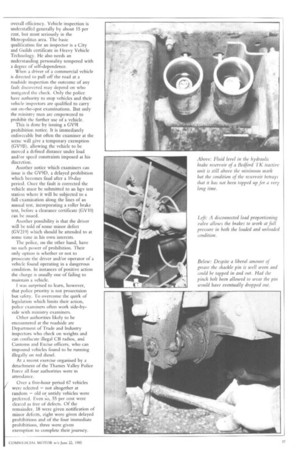PULL OVER!
Page 38

Page 39

If you've noticed an error in this article please click here to report it so we can fix it.
VEHICLE
SAFETY CHECK
Statistically, heavy goods vehicles are less likely to be involved in accidents than private cars. Does this reflect a high standard of maintenance? Bill Brock joined Thames Valley Police in a roadside check on lorry safety. Pictures by Ted Wright
THE SAFETY record for commercial vehicles is exemplary; over the 10-year period, up to 1983, the accident rate for heavy goods vehicles fell by about 42 per cent, and for light goods vehicles by 40 per cent. This compared with only a 22 per cent drop for private cars.
On a mileage basis the goods vehicle driver is six times less likely to be involved in a fatal accident than the private motorist, while the injury rate in accidents involving cvs is even lower.
Little information exists of the contribution vehicle defects make to injury accidents. However, between 1970 and 1974 the Transport and Road Research Laboratory investigated 2,000 accidents. Vehicle defects had made a major contribution to only 162 (8.1 per cent) of them.
Road Accidents Great Britain 1983 published by the Government Statistical Unit states that, unlike the private car, "neither buses and coaches nor hgvs show much trend in accident involvement with age. In most cases the vehicles are likely to be well maintained."
This safety trend is in some part a reflection of steadily improved maintenance standards promoted by annual plating and testing — and not least by Department of Transport examiners who also visit companies' premises to inspect vehicles during the course of their daily operations.
Although much talk recently of the possible privatisation of the DTp's testing stations came to nought it drew attention to the way vehicle examination is operated nationally.
This month new technology will be introduced to improve communications, cut down on paperwork and improve overall efficiency. Vehicle inspection is understaffed generally by about 15 per cent, but most seriously in the Metropolitan area. The basic qualification for an inspector is a City and Guilds certificate in Heavy Vehicle Technology. He also needs an understanding personality tempered with a degree of self-dependence.
When a driver of a commercial vehicle is directed to pull off the road at a roadside inspection the outcome of any fault discovered may depend on who instigated the check. Only the police have authority to stop vehicles and their vehicle inspectors are qualified to carry out on-the-spot examinations. But only the ministry men are empowered to prohibit the further use of a vehicle.
This is done by issuing a GV9I prohibition notice. It is immediately enforceable but often the examiner at the scene will give a temporary exemption (GV9B), allowing the vehicle to be moved a defined distance under load and/or speed constraints imposed at his discretion.
Another notice which examiners can issue is the GV9D, a delayed prohibition which becomes final after a 10-day period. Once the fault is corrected the vehicle must be submitted to an hgv test station where it will be subjected to a full examination along the lines of an annual test, incorporating a roller brake test, before a clearance certificate (GV10) can be issued.
Another possibility is that the driver will be told of some minor defect (GV219) which should be attended to at sonic time in his own interests.
The police, on the other hand, have no such power of prohibition. Their only option is whether or not to prosecute the driver and/or operator of a vehicle found operating in a dangerous condition. In instances of positive action the charge is usually one of failing to maintain a vehicle.
I was surprised to learn, however, that police priority is not prosectuion but safety. To overcome the quirk of legislation which limits their action, police examiners often work side-byside with ministry examiners.
Other authorities likely to be encountered at the roadside are Department of Trade and Industry inspectors who check on weights and can confiscate illegal CB radios, and Customs and Excise officers, who can impound vehicles found to be running illegally on red diesel.
At a recent exercise organised by a detachment of the Thames Valley Police Force all four authorities were in attendance.
Over a five-hour period 67 vehicles were selected — not altogether at random — old or untidy vehicles were preferred. Even so, 55 per cent were cleared as free of defects. Of the remainder, 18 were given notification of' minor defects, eight were given delayed prohibitions and of the four immediate prohibitions, three were given exemption to complete their journey.




































































































